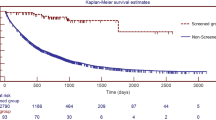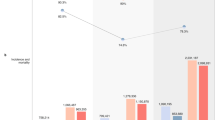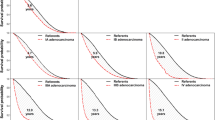Abstract
Globally, lung cancer is the leading cause of cancer death. Previous trials demonstrated that low-dose computed tomography lung cancer screening of high-risk individuals can reduce lung cancer mortality by 20% or more. Lung cancer screening has been approved by major guidelines in the United States, and over 4,000 sites offer screening. Adoption of lung screening outside the United States has, until recently, been slow. Between June 2017 and May 2019, the Ontario Lung Cancer Screening Pilot successfully recruited 7,768 individuals at high risk identified by using the PLCOm2012noRace lung cancer risk prediction model. In total, 4,451 participants were successfully screened, retained and provided with high-quality follow-up, including appropriate treatment. In the Ontario Lung Cancer Screening Pilot, the lung cancer detection rate and the proportion of early-stage cancers were 2.4% and 79.2%, respectively; serious harms were infrequent; and sensitivity to detect lung cancers was 95.3% or more. With abnormal scans defined as ones leading to diagnostic investigation, specificity was 95.5% (positive predictive value, 35.1%), and adherence to annual recall and early surveillance scans and clinical investigations were high (>85%). The Ontario Lung Cancer Screening Pilot provides insights into how a risk-based organized lung screening program can be implemented in a large, diverse, populous geographic area within a universal healthcare system.
This is a preview of subscription content, access via your institution
Access options
Access Nature and 54 other Nature Portfolio journals
Get Nature+, our best-value online-access subscription
$29.99 / 30 days
cancel any time
Subscribe to this journal
Receive 12 print issues and online access
$209.00 per year
only $17.42 per issue
Buy this article
- Purchase on Springer Link
- Instant access to full article PDF
Prices may be subject to local taxes which are calculated during checkout

Similar content being viewed by others
Data availability
The Ontario Lung Cancer Screening Pilot was not conducted as a research study. For the Ontario Lung Cancer Screening Pilot, Ontario Health operated as a prescribed entity under Ontario’s health privacy law, the Personal Health Information Protection Act (PHIPA), 2004, S.O. 2004, c. 3, Sched. A. Section 45(1) of PHIPA stipulates that ‘a health information custodian may disclose to a prescribed entity personal health information for the purpose of analysis or compiling statistical information with respect to the management of, evaluation or monitoring of, the allocation of resources to or planning for all or part of the health system, including the delivery of services, if the entity meets the requirements under the subsection’. Ontario Health was authorized to use the Pilot data for the purposes defined within PHIPA (monitoring, evaluation, health system planning and service delivery). It may be possible to disclose Pilot data in response to a research or health system planning request, but disclosure must occur on a case-by-case basis to ensure that each request meets the requirements defined within relevant Ontario laws and Ontario Health policies before disclosure. For example, Section 44 of PHIPA describes disclosure of the data for research, stipulating that there must be an application in writing, a research plan, documentation of approval from a research ethics board and a data transfer/disclosure agreement in place before disclosure of data. For more information, see https://www.ccohealth.ca/en/request-data-for-research, and, to initiate the process, contact OH-CCO_Datarequest@ontariohealth.ca. If the application is successful, it is expected that the process may take 3 months to complete, and costs to recover data preparation expenses will apply.
Code availability
Data collection was done at Pilot screening sites using data collection software prepared locally at the sites. Data were collected into CSV formatted files and were delivered by screening sites electronically to Ontario Health (Cancer Care Ontario). Data were appended into Microsoft Access databases and converted into Microsoft Excel (version 2016) or Stata (version 17) using standard procedures. Each site prepared their own information technology data collection system, which Ontario Health (Cancer Care Ontario) did not access. Because Ontario Health (Cancer Care Ontario) does not own or have access to the site data entry codes, they are not posted with the manuscript. The site-specific data collection software codes are not central to the research as they are simple routine systems that are universally available and fundamental to most spreadsheets, such as Excel.
Almost all Pilot analyses statistics were descriptive epidemiological and fell into the following three Stata codes (version 17):
1. Stata command for proportion and exact binomial 95% CI:
cii proportions #number_of_observations #number_of_successes
2. Stata command for comparing proportions between groups and estimating OR:
cci #number_outcomes_in_exposed_group #number_no_outcomes_in_exposed_group #number_outcomes_in_unexposed_group #number_no_outcomes_in_unexposed group
3. Stata command for testing the difference between a Pilot proportion and an established published proportion from the literature or meta-analysis:
bitesti #Number_in_Pilot_group_(denominator) #Number_of outcomes_in_Pilot_group #Proportion_outcomes_in_Literature/Meta-analysis
For more information regarding coding, contact M.C.T. at martin.tammemagi@brocku.ca. A response can be expected within 2 months.
References
Sung, H. et al. Global Cancer Statistics 2020: GLOBOCAN estimates of incidence and mortality worldwide for 36 cancers in 185 countries. CA Cancer J. Clin. 71, 209–249 (2021).
Canadian Cancer Statistics: A 2020 Special Report on Lung Cancer (Canadian Cancer Society, 2020); https://cdn.cancer.ca/-/media/files/cancer-information/resources/publications/2020-canadian-cancer-statistics-special-report/2020-canadian-cancer-statistics-special-report-en.pdf
Aberle, D. R. et al. Reduced lung-cancer mortality with low-dose computed tomographic screening. N. Engl. J. Med. 365, 395–409 (2011).
de Koning, H. J. et al. Reduced lung-cancer mortality with volume CT screening in a randomized trial. N. Engl. J. Med. 382, 503–513 (2020).
Moyer, V. A. & U.S. Preventive Services Task Force.Screening for lung cancer: U.S. Preventive Services Task Force recommendation statement. Ann. Intern. Med. 160, 330–338 (2014).
Screening for Lung Cancer with Low Dose Computed Tomography (LDCT) (CAG-00439N) (Centers for Medicare & Medicaid Services, 2015); https://www.cms.gov/medicare-coverage-database/view/ncacal-decision-memo.aspx?proposed=N&NCAId=274
The US national lung cancer screening programme. Lung Cancer Policy Network https://www.lungcancerpolicynetwork.com/the-us-national-lung-cancer-screening-programme/ (2022).
Interactive map of lung cancer screening. Lung Cancer Policy Network https://www.lungcancerpolicynetwork.com/now-available-interactive-map-of-lung-cancer-screening-implementation/ (2022).
Schneider, E. et al. Mirror, mirror 2021: reflecting poorly—health care in the U.S. compared to other high-income countries. The Commonwealth Fund https://www.commonwealthfund.org/publications/fund-reports/2021/aug/mirror-mirror-2021-reflecting-poorly (2021).
Ivers, N., Brown, A. D. & Detsky, A. S. Lessons from the Canadian experience with single-payer health insurance: just comfortable enough with the status quo. JAMA Intern. Med. 178, 1250–1255 (2018).
de Koning, H. J. et al. Reduced lung-cancer mortality with volume CT screening in a randomized trial. N. Engl. J. Med. 382, 503–513 (2020).
Mazzone, P. J., White, C. S., Kazerooni, E. A., Smith, R. A. & Thomson, C. C. Proposed quality metrics for lung cancer screening programs: a National Lung Cancer Roundtable project. Chest 160, 368–378 (2021).
Candal-Pedreira, C., Ruano-Ravina, A., Provencio, M., Fernandez-Villar, A. & Perez-Rios, M. Lung cancer screening quality criteria: a population perspective. Chest 160, e329–e331 (2021).
Canadian Partnership Against Cancer & Pan-Canadian Lung Cancer Screening Network. National Lung Cancer Screening Quality Indicators Report, 1st edn (Canadian Partnership Against Cancer, 2017).
Martin, D. et al. Canada’s universal health-care system: achieving its potential. Lancet 391, 1718–1735 (2018).
Ellison L. F. & Saint-Jacques N. Five-year cancer survival by stage at diagnosis in Canada. Health Rep. 34, 3–15 (2023).
Wait Times (Ontario Health, 2021); https://www.ontariohealth.ca/public-reporting/wait-times
Habbous, S. et al. The effect of diagnostic assessment programs on the diagnosis and treatment of patients with lung cancer in Ontario, Canada. Ann. Thorac. Med. 16, 81–101 (2021).
Elrod, J. K. & Fortenberry, J. L. Jr. The hub-and-spoke organization design: an avenue for serving patients well. BMC Health Serv. Res. 17, 457 (2017).
Kucharczyk, M. J., Menezes, R. J., McGregor, A., Paul, N. S. & Roberts, H. C. Assessing the impact of incidental findings in a lung cancer screening study by using low-dose computed tomography. Can. Assoc. Radio. J. 62, 141–145 (2011).
Regis, S. M. et al. Outcomes of positive and suspicious findings in clinical computed tomography lung cancer screening and the road ahead. Ann. Am. Thorac. Soc. 19, 1371–1378 (2022).
Lopez-Olivo, M. A. et al. Patient adherence to screening for lung cancer in the US: a systematic review and meta-analysis. JAMA Netw. Open 3, e2025102 (2020).
Field, J. K. et al. The UK Lung Cancer Screening Trial: a pilot randomised controlled trial of low-dose computed tomography screening for the early detection of lung cancer. Health Technol. Assess. 20, 1–146 (2016).
Jonas, D. E. et al. Screening for lung cancer with low-dose computed tomography: updated evidence report and systematic review for the US Preventive Services Task Force. JAMA 325, 971–987 (2021).
Bach, P. B. et al. Benefits and harms of CT screening for lung cancer: a systematic review. JAMA 307, 2418–2429 (2012).
Tammemagi, M. C. et al. Selection of individuals for lung cancer screening based on risk prediction model performance and economic factors—the Ontario experience. Lung Cancer 156, 31–40 (2021).
Slatore, C. G., Sullivan, D. R., Pappas, M. & Humphrey, L. L. Patient-centered outcomes among lung cancer screening recipients with computed tomography: a systematic review. J. Thorac. Oncol. 9, 927–934 (2014).
Ten Haaf, K. et al. Performance and cost-effectiveness of computed tomography lung cancer screening scenarios in a population-based setting: a microsimulation modeling analysis in Ontario, Canada. PLoS Med. 14, e1002225 (2017).
Huo, Y. R., Chan, M. V., Habib, A. R., Lui, I. & Ridley, L. Pneumothorax rates in CT-guided lung biopsies: a comprehensive systematic review and meta-analysis of risk factors. Br. J. Radiol. 93, 20190866 (2020).
Indigenous Peoples in Ontario (Ministry of Indigenous Affairs, 2018); https://www.ontario.ca/document/spirit-reconciliation-ministry-indigenous-relations-and-reconciliation-first-10-years/indigenous-peoples-ontario
Chiefs of Ontario and Cancer Care Ontario. Cancer in First Nations in Ontario: Risk Factors and Screening. https://www.cancercareontario.ca/en/statistical-reports/cancer-first-nations-ontario-risk-factors-and-screening-report (2017).
Targeted Screening for Lung Cancer with Low Radiation Dose Computed Tomography: Standard Protocol Prepared for the Targeted Lung Health Checks Programme (NHS England, 2019); https://www.england.nhs.uk/publication/targeted-screening-for-lung-cancer/
Allemani, C. et al. Global surveillance of trends in cancer survival 2000–14 (CONCORD-3): analysis of individual records for 37 513 025 patients diagnosed with one of 18 cancers from 322 population-based registries in 71 countries. Lancet 391, 1023–1075 (2018).
Arnold, M. et al. Progress in cancer survival, mortality, and incidence in seven high-income countries 1995–2014 (ICBP SURVMARK-2): a population-based study. Lancet Oncol. 20, 1493–1505 (2019).
Rivera, M. P. et al. Receipt of recommended follow-up care after a positive lung cancer screening examination. JAMA Netw. Open 5, e2240403 (2022).
National Lung Screening Trial Research Trial. Results of initial low-dose computed tomographic screening for lung cancer. N. Engl. J. Med. 368, 1980–1991 (2013).
Aberle, D. R. et al. Results of the two incidence screenings in the National Lung Screening Trial. N. Engl. J. Med. 369, 920–931 (2013).
Pinsky, P. F. et al. Performance of Lung-RADS in the National Lung Screening Trial: a retrospective assessment. Ann. Intern. Med. 162, 485–491 (2015).
Ontario Lung Screening Program Locations (Ontario Health (Cancer Care Ontario), 2020); https://www.cancercareontario.ca/en/find-cancer-services/ontario-lung-screening-program-locations
Darling, G. E. et al. Organized lung cancer screening pilot: informing a province-wide program in Ontario, Canada. Ann. Thorac. Surg. 111, 1805–1811 (2021).
Lung Screening Referral Form (Ontario Health (Cancer Care Ontario), 2020); https://www.cancercareontario.ca/sites/ccocancercare/files/assets/LungCancerScreening_ReferralForm.pdf
Tammemagi, M. C. et al. Selection criteria for lung-cancer screening. N. Engl. J. Med. 368, 728–736 (2013).
Evans, W. K. et al. Integrating smoking cessation into low-dose computed tomography lung cancer screening: results of the Ontario, Canada pilot. J. Thorac. Oncol. 18, 1323–1333 (2023).
Lung CT Screening Reporting and Data System (Lung-RADS) (American College of Radiology, 2019); https://www.acr.org/Clinical-Resources/Reporting-and-Data-Systems/Lung-Rads
Lung-RADS® v2022 (American College of Radiology, 2022); https://www.acr.org/-/media/ACR/Files/RADS/Lung-RADS/Lung-RADS-2022.pdf
Lung-RADS® v2022. Summary of Changes and Updates (American College of Radiology, 2022); https://www.acr.org/-/media/ACR/Files/RADS/Lung-RADS/Lung-RADS-2022-Summary-_Final.pdf
Radiology Quality Assurance Program Manual–Ontario Lung Screening Program (Ontario Health (Cancer Care Ontario), 2021); https://www.cancercareontario.ca/sites/ccocancercare/files/assets/RadiologyQualityAssuranceProgramManual.pdf
Darling, G. E. et al. Organized lung cancer screening pilot: informing a province-wide program in Ontario, Canada. Ann. Thorac. Surg. 111, 1805–1811 (2021).
Acknowledgements
We acknowledge the important contributions made by all participants and staff at the lung cancer screening Pilot sites, including but not limited to the following individuals at Lakeridge Health (S. Ashton, J. Bell, L. Brown, D. Cook, J. Dickie, G. Dotsikas, S. Galica, R. Hamilton, M. Kyte, J. Losier, P. Marchand, A. Mehta, O. Nnorom, T. Tepfenhart, C. Vanderkooi and S. Wong); The Ottawa Hospital (E. Alie, C. Anstee, C. Bornais, J. De Loe, C. Dennie, W. Doyle, A. Gaudet, C. Malenfant, D. Maziak, M. Otley, A. St. Hill and L. Stoica); Health Sciences North; and the Cancer Care Ontario Access to Care team, and to N. Sandhu, B. McCurdy, C. Neilson, M. Ang, T. Patel, T. Hung, K. Wong and A. Langan.
Author information
Authors and Affiliations
Contributions
Each author made substantial contributions to the conception and design of the work or to the acquisition, analysis or interpretation of data or drafted the work or substantively revised it. All authors approved the submitted version of this manuscript and have agreed both to be personally accountable for their own contributions and to ensure that questions related to the accuracy or integrity of any part of the work, even ones in which they were not personally involved, are appropriately investigated and resolved and the resolution documented in the literature. Parts of this material are based on data and information compiled and provided by the Canadian Institute for Health Information, the Institute for Clinical Evaluative Sciences and the Ontario Ministry of Health. Any conclusions, opinions, results or statements contained in this publication are those of the authors and do not necessarily represent those of the aforementioned, nor should their endorsement be inferred. This study was funded with the support of Ontario Health (Cancer Care Ontario) through funding provided by the Government of Ontario. Ontario Health (Cancer Care Ontario) acknowledges the support of the Ontario Ministry of Health. The opinions, results, views and conclusions reported in this publication are those of the authors and do not necessarily reflect those of Ontario Health (Cancer Care Ontario) or the Ontario Ministry of Health. The opinions, results and conclusions reported in this paper are those of the authors and are independent of the funding sources.
Corresponding author
Ethics declarations
Competing interests
None of the authors had competing interests except for M.C.T. M.C.T. developed the PLCOm2012noRace lung cancer risk prediction model, which is used in the Pilot. The model is open access and is available free of charge to non-commercial users. For commercial users, licensing has been assigned to Brock University. To date, M.C.T. has not received any money for use of the PLCOm2012 model nor does he anticipate any payments in the future.
Peer review
Peer review information
Nature Medicine thanks Carlijn van der Aalst and the other, anonymous, reviewer(s) for their contribution to the peer review of this work. Primary Handling Editor: Ming Yang, in collaboration with the Nature Medicine team.
Additional information
Publisher’s note Springer Nature remains neutral with regard to jurisdictional claims in published maps and institutional affiliations.
Extended data
Extended Data Fig. 1 Locations of Ontario Pilot lung cancer screening sites.
Locations of Ontario Pilot sites.
Extended Data Fig. 2 Simplified Ontario Pilot lung cancer screening pathway.
Lung cancer screening Pilot pathway.
Extended Data Fig. 3 The initially planned Ontario Pilot evaluation framework.
Initial evaluation framework for the Ontario Pilot.
Supplementary information
Supplementary Information
Supplementary Text 1. PLCOm2012noRace model re-parameterized in Prostate, Lung, Colorectal And Ovarian Cancer Screening Trial control data. Table 1. Pilot patient satisfaction survey questions.
Rights and permissions
Springer Nature or its licensor (e.g. a society or other partner) holds exclusive rights to this article under a publishing agreement with the author(s) or other rightsholder(s); author self-archiving of the accepted manuscript version of this article is solely governed by the terms of such publishing agreement and applicable law.
About this article
Cite this article
Tammemägi, M.C., Darling, G.E., Schmidt, H. et al. Risk-based lung cancer screening performance in a universal healthcare setting. Nat Med 30, 1054–1064 (2024). https://doi.org/10.1038/s41591-024-02904-z
Received:
Accepted:
Published:
Issue Date:
DOI: https://doi.org/10.1038/s41591-024-02904-z



